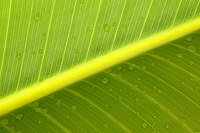Ravenala
| Ravenala | |
|---|---|

| |
| Scientific classification | |
| Kingdom: | |
| (unranked): | |
| (unranked): | |
| (unranked): | |
| Order: | |
| Family: | |
| Genus: | Ravenala |
| Species: | R. madagascariensis
|
| Binomial name | |
| Ravenala madagascariensis | |
Ravenala is a genus of flowering plants with a single species, Ravenala madagascariensis, commonly known as traveller's tree or traveller's palm, from Madagascar. It is not a true palm (family Arecaceae) but a member of a monocotyledonous flowering plant family, Strelitziaceae. The genus is closely related to the southern African genus Strelitzia and the South American genus Phenakospermum. Some older classifications include these genera in the banana family (Musaceae). Although it is usually considered to be a single species, four different forms have been distinguished.[1][2]
Name
It has been given the name "traveller's palm" because the sheaths of the stems hold rainwater, which supposedly could be used as an emergency drinking supply for needy travellers.[3] However, the water inside the plant is murky, black and smelly and should not be consumed without purification. Another plausible reason for its name is that the fan tends to grow on an east-west line, providing a crude compass.[4]
The scientific name Ravenala comes from Malagasy ravinala meaning "forest leaves".[5]
Description
The enormous paddle-shaped leaves are borne on long petioles, in a distinctive fan shape aligned in a single plane. The large white flowers are structurally similar to those of its relatives, the bird-of-paradise flowers Strelitzia reginae and Strelitzia nicolai, but are generally considered less attractive, with a green bract.[6] In tropical and subtropical regions, the plant is widely cultivated for its distinctive habit and foliage. As the plant grows older, it progressively loses the lowest or oldest leaves and reveals a sturdy grey trunk.
Ecology
Ruffed lemurs are a known pollinator of this plant, and given the size and structure of the inflorescences, as well as the lemur's selectivity, method of feeding, and long muzzle, this relationship is thought to have coevolved.[7]
Culture
The plant requires a sunny spot (not full sun until it is larger). It responds well to fertiliser, especially if it is high in nitrogen during the growing season. This produces better growth and foliage. The plant grows to an average height of 7 m (23 ft) and requires moderate water.
Gallery
-
Use in urban setting
-
In a park of Phnom Penh
-
Travellers Palm and flower, India
-
Detail of a leaf's structure
-
Seeds
-
Bark
-
The old petioles dry out brown
References
- ^ Patrick Blanc; Nelson Rabenandrianina; Annette Hladik; Claude Marcel Hladik (1999). "Les formes sympatriques et allopatriques du genre Ravenala dans les forêts et les milieux ouverts de l'est de Madagascar". Revue d'Ecologie, Terre et Vie. 54: 201–223.
{{cite journal}}: Unknown parameter|last-author-amp=ignored (|name-list-style=suggested) (help) - ^ P. Blanc, A. Hladik, N. Rabenandrianina, J.S. Robert and C.M. Hladik (2003). "Strelitziaceae: The variants of Ravenala in natural and anthropogenic habitats". In Goodman, S.M. & Benstead, J. (ed.). The Natural History of Madagascar (PDF). The University of Chicago Press, Chicago & London. pp. 472–476.
{{cite book}}: CS1 maint: multiple names: authors list (link) - ^ McLendon, Chuck (May 16, 2000). "Ravenala madagascariensis". Floridata.com. Retrieved September 14, 2009.
- ^ "Botanical Journeys Plant Guides". www.botanical-journeys-plant-guides.com. 2008–2010. Retrieved Feb 28, 2011.
- ^ Sargent, Charles Sprague (1893). "Garden and Forest: A Journal of Horticulture, Landscape Art and Forestry". 6 (282). Garden and Forest Publishing Company.
{{cite journal}}: Cite journal requires|journal=(help) - ^ M. Calley, R. W. Braithwaite and P. G. Ladd (1993). "Reproductive Biology of Ravenala madagascariensis Gmel. as an Alien Species". Biotropica. 25 (1): 61–72. doi:10.2307/2388979.
- ^ Garbutt, Nick (2007). Mammals of Madagascar, A Complete Guide. A&C Black Publishers. pp. 170–175. ISBN 978-0-300-12550-4.
External links
 Media related to Ravenala madagascariensis (Travelers Palm) at Wikimedia Commons
Media related to Ravenala madagascariensis (Travelers Palm) at Wikimedia Commons- Floridata.com: Ravenala madagascariensis
- University of Florida — Ravenala madagascariensis







